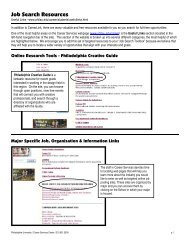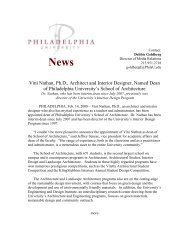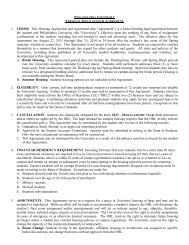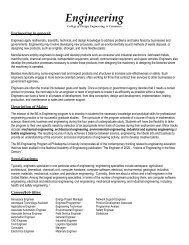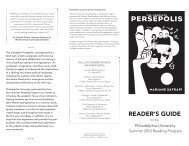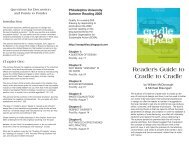A Chindogu must exist - Philadelphia University
A Chindogu must exist - Philadelphia University
A Chindogu must exist - Philadelphia University
You also want an ePaper? Increase the reach of your titles
YUMPU automatically turns print PDFs into web optimized ePapers that Google loves.
A CHINDOGU<br />
MUST EXIST<br />
by Evan Ratliff<br />
photos by Julie Marquart<br />
Don’t Laugh: Those Wacky<br />
Japanese Inventions Are<br />
Making a Comeback.<br />
THUMBZIPPERRING<br />
Designer: Ryan Moore<br />
Problem: Thick digits incapable of<br />
snatching zipper.<br />
Solution: Loop facilitates easy grab.<br />
48
INSTRUCTIONALPLACEMAT<br />
We’d be millionaires. Our idea was bigger than<br />
our Handy-Sun palm-shaped sunscreen applicator<br />
or Jesucles Christian-themed Popsicles. The<br />
device: a thin piece of clear plastic embedded<br />
with what appeared to be broken glass. Stashed<br />
in the trunk of a car, it could be rolled out into a<br />
neighborhood parking space upon departure,<br />
deterring fellow drivers from nabbing coveted<br />
spots. We branded it the Shatter-Park. We<br />
would patent it. Pay dirt would follow.<br />
The Shatter-Park, it turned out, was no idle<br />
barstool concoction. It was a <strong>Chindogu</strong>, in the<br />
same class as breakthroughs like the Hay Fever<br />
Hat (which dispenses toilet paper for nose-blowing),<br />
the Soap Recycler (a vice that mashes leftover<br />
bits together), and the Portable Stoplight (a handheld<br />
traffic signal for pedestrians). These and hundreds<br />
more are the brainchildren of Japan’s Kenji<br />
Kawakami, creator of the decade-old art of “unuseless<br />
invention.” Literally, <strong>Chindogu</strong> means “strange tool” (the<br />
“unuseless” tag refers to objects that, while not exactly<br />
without purpose, barely justify their own <strong>exist</strong>ence). In<br />
short, they are objects whose designs go to extraordinary—and<br />
often ridiculously cumbersome—lengths to<br />
solve everyday problems.<br />
In the early 1990s, Kawakami, now 55, dreamed up all<br />
kinds of unuseless objects while editing a Japanese magazine<br />
that reviewed mail order catalogs. A former<br />
scriptwriter for television and designer of the Japanese<br />
Bicycle Museum, Kawakami published a few of his inventions<br />
and discovered that they were wildly popular<br />
among his readers. Around the same<br />
time, he crossed paths with Dan Papia,<br />
who edited the English-language magazine<br />
Tokyo Journal, and whose claim to<br />
fame was christening the Tokyo Dome<br />
the Big Egg. Papia helped Kawakami<br />
10<br />
of<br />
1ne<br />
2wo<br />
Designer: Emory Krall<br />
Problem: Table setting protocols complex<br />
and difficult to remember.<br />
Solution: Provide detailed template.<br />
1 2 3 4 5 6 7 8 9 10<br />
TENETS<br />
CHINDOGU<br />
Adapted from Kenji Kawakami’s<br />
101 Unuseless Japanese Inventions:<br />
The Art of <strong>Chindogu</strong><br />
<strong>Chindogu</strong> cannot be for real use.<br />
It is fundamental to the spirit of <strong>Chindogu</strong> that inventions claiming<br />
<strong>Chindogu</strong> status <strong>must</strong> be, from the practical point of view,<br />
(almost) completely useless. If you invent something which turns<br />
out to be so handy that you use it all the time, then you have<br />
failed to make a <strong>Chindogu</strong>. Try the Patent Office.<br />
A <strong>Chindogu</strong> <strong>must</strong> <strong>exist</strong>.<br />
You’re not allowed to use a <strong>Chindogu</strong>, but it <strong>must</strong> be made. You<br />
have to be able to hold it in your hand and think, “I can actually<br />
imagine someone using this. Almost.” In order to be useless, it<br />
<strong>must</strong> first be.<br />
49
1 2 3 4 5 6 7 8 9 10<br />
TABLETRASHCAN<br />
“CHINDOGU IS THE ANTITHE<br />
PROFESSOR JOSH OWEN.<br />
4our<br />
5ive<br />
Designer: Shaun Smith<br />
Problem: Energy spent transporting<br />
trash from table to receptacle.<br />
Solution: Eliminate distance variable.<br />
Inherent in <strong>Chindogu</strong> is the spirit of anarchy.<br />
3hree <strong>Chindogu</strong> are man-made objects that have broken free from the<br />
chains of usefulness. They represent freedom of thought and<br />
action: the freedom to challenge the suffocating historical dominance<br />
of conservative utility; the freedom to be (almost) useless.<br />
<strong>Chindogu</strong> are tools for everyday life.<br />
<strong>Chindogu</strong> are a form of nonverbal communication understandable<br />
to everyone, everywhere. Specialized or technical inventions,<br />
like a three-handled sprocket loosener for drain pipes centered<br />
between two under-the-sink cabinet doors (the uselessness of<br />
which will only be appreciated by plumbers) do not count.<br />
<strong>Chindogu</strong> are not for sale.<br />
<strong>Chindogu</strong> are not tradable commodities. If you accept money<br />
for one you surrender your purity. They <strong>must</strong> not even be sold<br />
as a joke.<br />
assemble his oddball ideas into a book. Though it was to<br />
be published in English, Papia thought a Japanese name<br />
would give it credibility. “I wanted it to sound like an<br />
ancient art,” he says. The book, 101 Unuseless Japanese<br />
Inventions: The Art of <strong>Chindogu</strong>, appeared in 1993. Spurred<br />
by healthy sales, Papia and Kawakami issued 99<br />
More Unuseless Japanese Inventions two years<br />
later. The books spawned the formation of<br />
<strong>Chindogu</strong> clubs around the world and led to the<br />
founding of the International <strong>Chindogu</strong><br />
Society—the paperback of the first edition<br />
claims the organization “10,000 strong”—<br />
and turned Kawakami into a minor celebrity<br />
in Japan.<br />
After the second book’s publication, though,<br />
Papia and Kawakami were split over the movement’s<br />
philosophical direction. In the U.S., talks with David<br />
Letterman’s Late Show fell through, and plans for 101<br />
Unuseless American Inventions, never got off the ground.<br />
Though Papia had already begun moving on to other<br />
things, he was chagrined by the winnowing of interest. He<br />
had big plans for <strong>Chindogu</strong>, envisioning it as a participatory<br />
design revolution for the masses. “My goal was to get<br />
the word into the dictionary, like karate and karaoke and<br />
other Japanese words,” he says. “I wanted to see it catch<br />
on as an art form,” whereas Kawakami, Papia complains,<br />
“wanted it to just sort of be his.” Not long after the second<br />
book came out, Papia returned to the States, where he<br />
enrolled in film school and started a new life as a screenwriter.<br />
Meanwhile, Kawakami rode out his notoriety in<br />
Japan. <strong>Chindogu</strong> seemed confined to the Table<br />
Trash Can of history.<br />
Not entirely. In the classrooms of American<br />
design schools, the art of unuseless design is<br />
enjoying an unexpected revival. Josh Owen, a<br />
professor of industrial design at the <strong>University</strong> of<br />
<strong>Philadelphia</strong>, employs <strong>Chindogu</strong> as a teaching tool to force<br />
students to solve everyday problems with everyday materials.<br />
<strong>Chindogu</strong>, he says, “is the antithesis of the styledriven<br />
approach. Students are freed from market research,<br />
from ‘taste-based user scenarios.’”<br />
In their projects, Owen and his students adhere strictly<br />
to the 10 Tenets of <strong>Chindogu</strong>, laid out by Kawakami in his<br />
first book (see sidebar, page 49). Among these: “<strong>Chindogu</strong><br />
cannot be patented or sold,” “<strong>Chindogu</strong> <strong>must</strong> <strong>exist</strong>,”<br />
and “<strong>Chindogu</strong> are never taboo.” Most important,<br />
they <strong>must</strong> be “tools for everyday life” that embody a<br />
“spirit of anarchy—the freedom to be almost useless.” In<br />
Owen’s thinking, a <strong>Chindogu</strong> is “that long-winded ‘better<br />
mousetrap’ that takes too many steps to produce an<br />
effect.” Indeed, Owen and his students carefully vet each<br />
50
SIS OF STYLE,” SAYS DESIGN 1 2 3 4 5 6 7 8 9 10<br />
6ix<br />
Humor <strong>must</strong> not be the sole reason for<br />
creating <strong>Chindogu</strong>.<br />
WATCHVIEWJACKET<br />
The creation of <strong>Chindogu</strong> is fundamentally a problem-solving<br />
activity. Humor is simply the byproduct of finding an elaborate<br />
or unconventional solution to a problem that may not<br />
have been pressing to begin with.<br />
7even<br />
<strong>Chindogu</strong> are not propaganda.<br />
<strong>Chindogu</strong> are innocent. They are made to be used, even though<br />
they cannot be used. They should not be created as a perverse or<br />
ironic comment on the sorry state of mankind.<br />
8ight<br />
<strong>Chindogu</strong> are never taboo<br />
The International <strong>Chindogu</strong> Society has established certain standards<br />
of social decency. Cheap sexual innuendo, humor of a<br />
vulgar nature, and sick or cruel jokes that debase the sanctity<br />
of living things are not allowed.<br />
Designer: Trina Lefevre<br />
Problem: Sleeve blocks view of watch.<br />
Solution: Permanent window allows<br />
unimpeded access.<br />
TIEBIB<br />
Designer: Jarrett Seng<br />
Problem: Saucy foods splatter<br />
fancy work clothes.<br />
Solution: Stealthy bib folds<br />
out of unassuming tie.<br />
More<br />
<strong>Chindogu</strong>,<br />
please.<br />
51
1 2 3 4 5 6 7 8 9 10<br />
Designer: Marc Caccavo<br />
Problem: Risk of splashes during<br />
plunging action.<br />
Solution: Allows for plunging while<br />
toilet lid is down.<br />
9ine<br />
10en<br />
<strong>Chindogu</strong> can never be patented.<br />
<strong>Chindogu</strong> are offerings to the rest of the world—they are not<br />
therefore ideas to be copyrighted, patented, collected, and<br />
owned. As they say in Spain, Mi <strong>Chindogu</strong> Es Tu <strong>Chindogu</strong>.<br />
<strong>Chindogu</strong> are without prejudice.<br />
CHINDOGU<br />
STAYDRYPLUNGER<br />
<strong>Chindogu</strong> <strong>must</strong> never favor one race or religion over another.<br />
Young and old, male and female, rich and poor—all should have<br />
a free and equal chance to enjoy each and every <strong>Chindogu</strong>.<br />
proposed <strong>Chindogu</strong> to make sure it’s<br />
not too useful. Some of the projects<br />
that made the cut include the Watch<br />
Window Jacket (with a section cut from the<br />
sleeve for reading your watch), the Table<br />
Trash Can (with a hole at the center for waste disposal),<br />
and the Carpet Remnant Carpet (created by fastening<br />
together scraps and samples). “The tenets,” Owen<br />
says, “are extremely effective in dictating a procedure for<br />
making an object that is really devoid of any sort of superficial<br />
style.”<br />
Owen incorporates the spirit of unuselessness into his<br />
own work, which often features renewed takes on common<br />
objects. His latest creation, the Knock-Off Lamp, sold by<br />
Bozart, is a bowling pin light that turns off when tipped<br />
over. “That’s where product design gets fun,” he<br />
says, “when it causes you to rethink the ordinary.”<br />
Don Norman, a professor of computer<br />
science at Northwestern <strong>University</strong> and the<br />
author of Design of Everyday Things, recommends<br />
Kawakami’s books to his students.<br />
“It appeals to my bizarre sense of<br />
humor,” Norman says. While <strong>Chindogu</strong><br />
are useless, or nearly so, they hit a<br />
Seinfeld-esque, design-about-nothing<br />
nerve—think Kramer’s coffee table book as coffee table—<br />
highlighting the absurdity of daily life. “You can’t come up<br />
with these things without actually having thought about<br />
what people do throughout the day,” Norman says. “It<br />
exposes real problems, often through silly solutions.”<br />
A decade after the first <strong>Chindogu</strong> book appeared, it has<br />
become required reading among industrial designers.<br />
“The wonderful thing about <strong>Chindogu</strong> is you think to yourself,<br />
‘Well, that could work,’” Owen says. Kawakami,<br />
meanwhile, has produced several Japanese-language follow-ups<br />
to his first edition, and of late has been working<br />
with Hollywood producers on a live television show à la<br />
Iron Chef. Papia, for his part, now presides as president of<br />
the International <strong>Chindogu</strong> Society. He still receives submissions<br />
and has been collecting them for another book.<br />
Greatest hits thus far include Exercise Chopsticks for<br />
strengthening fingers and Pitstopper sponges that keep<br />
your armpits dry.<br />
The art of <strong>Chindogu</strong> perseveres, but so far the fortunes<br />
from our Shatter-Park have yet to materialize. The truth is<br />
we never got around to making it. But in a remarkable<br />
example of spontaneous generation, one of Owen’s students<br />
did. He created a broken glass-like rollout called<br />
the Space Saver made from a special rubber developed<br />
by a Hollywood props company. Faithful to<br />
the spirit of <strong>Chindogu</strong>, he never marketed it.<br />
52
shirts available at www.readymademag.com



